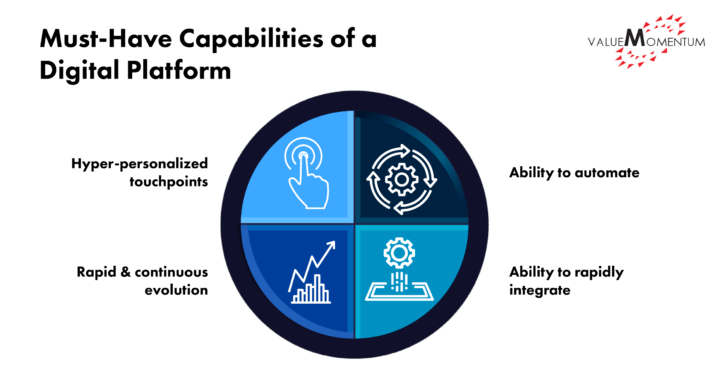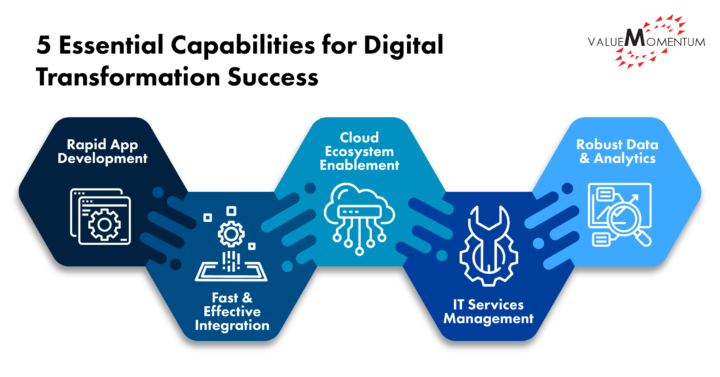The OECD reported that internet traffic increased by as much as 60% in some countries with the emergence of COVID-19, and in a McKinsey survey of nearly 900 executives, most companies reported accelerating their customer, supply-chain, and internal operations digitalization journeys by three to four years.
The insurance industry was no exception. Thousands of employees shifted to working from home almost literally overnight, and processes that were on the digitalization roadmap for a few years later got bumped up to the highest priority. IT teams were front and center of these changes, working hard to implement these capabilities while maintaining security and meeting compliance.
Now, in 2023, digital platforms are more important than ever: Having robust digital capabilities is no longer a differentiator. It’s a baseline expectation customers, agents, and employees have.
Digital platforms fuel digital transformation in insurance
The importance of top-of-the-line digital capabilities will only continue to grow. The inevitability of digital business ecosystems and the need for ongoing digital transformation in order to stay competitive are not new. The difference between the insurance industry of 2019 and that of 2023, however, is that more insurers are further along in their digital transformation journey.

By now, insurers all know that a digital platform is a set of technology solutions that enable digital interactions between communities of partners, providers, and customers. A digital platform must have capabilities that allow:
- Hyper-personalized touchpoints where employees, partners, and customers can find the information they need whenever they need it and through their preferred channel
- Rapid and continuous evolution, so insurers can deliver innovative products and services through the many channels customers have come to expect
- The ability to automate and make processes intelligent
- The ability to rapidly integrate with multiple distribution platforms, provide multiple point-of-sale options (including direct to consumer), and be adapted to suit different business models
A proven framework delivers success
When we partner with insurers to create or modernize a digital platform, the first step is helping you develop a digital transformation strategy using our proven framework. We help you articulate your business strategy, then we analyze your existing IT environment to determine what changes may be necessary to achieve that strategy.
Once we have analyzed your current technology capabilities, we develop a customized plan to evolve your IT environment accordingly.
A key outcome of our framework is infusing your digital platform with five essential capabilities for digital transformation success. These five essential capabilities and what they enable are:
- Rapid app development to create exceptional multichannel experiences
- Fast and effective integration, including microservices architecture and API gateways, to enable rapid development of multiple functionalities
- Cloud ecosystem enablement to support a dynamic infrastructure
- IT services management to automate processes and create business-enhancing solutions
- Robust data and analytics to support insights-driven business innovation

Let’s take a closer look at each essential capability.
Rapid App Development
Unlike traditional long development and QA cycles, rapid app development favors quickly producing working software, gaining immediate feedback, and then iterating rapidly. The objective is to create immersive and natural engagement experiences on whatever digital channels a customer chooses, leaving room for these experiences to rapidly evolve as needs and expectations change. Providing channel-specific experiences is critical to creating the exceptional experiences that win partners and customers.
Fast and Effective Integration
Similar to rapid app development, successful digital platforms provide quick and effective means to develop APIs and enable integration with partners to leverage new market opportunities and non-traditional distribution channels. Technologies such as open APIs, microservices, and integration-oriented architectures are fundamental to fast and effective integration. Such capabilities also allow your team to improve products, services, and operations to become more nimble and responsive.
Cloud Enablement
Cloud deployment is largely the norm in the insurance industry. Moving infrastructure and operations to the cloud enables you to utilize dynamic infrastructure and services, optimize your IT environment, and leverage automation, which provides flexibility for scaling your business and improving profitability. A well-designed and implemented cloud environment supplies insurers with the right tools, computing resources, storage, and network to develop and deploy applications according to business and market needs.
IT Services Management
Internal user experiences are just as important to competitiveness and profitability as customer experiences. By providing your IT and business teams with the right building blocks, you can streamline internal processes and provide consumer-like experiences to your employees. Not only will your internal teams be better equipped to support customer engagement with automated solutions on the back end, but harnessing the benefits of a cloud-based digital system internally helps improve employee engagement, help attract top talent, and positively boost retention.
Robust Data and Analytics
Data is the foundation for achieving innovation with digital initiatives. Luckily, it’s abundantly available within insurance organizations. The trick is having the right data strategy for harnessing and using that data to make informed decisions, drive smart actions, and bring transformational value to your business. Robust data and analytics capabilities enable improved products and services, deeper insights into customer needs, development of new revenue streams, and the updating of business models.
From our experiences working with dozens of insurers, we’ve seen how these five capabilities can make or break the success of an insurer’s digital platform. That’s why establishing strength in these five capabilities will help ensure you’re ready to win in a rapidly evolving, ecosystem-driven marketplace.
Ready to start your digital transformation journey? Learn how our Digital & Cloud team can help you develop these five essential digital platform capabilities.
